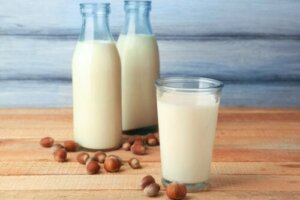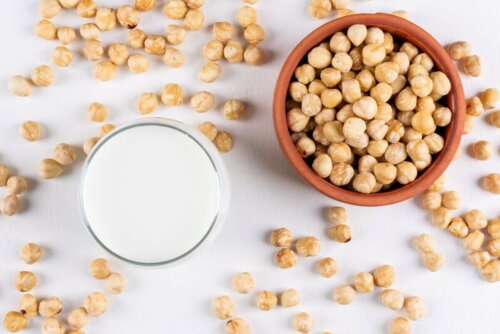The Properties of Hazelnut Milk


Written and verified by the nutritionist Florencia Villafañe
The properties of hazelnut milk are useful to take advantage of if you’re vegan, vegetarian, or suffer from lactose intolerance. Although most people know it by this name, we could say that it’s actually a vegetable drink made with hazelnuts and water that contains the nutrients of this nut. That’s where its properties come from.
Do you know its many benefits? Keep reading to find out!
The properties of hazelnut milk
Although its chemical composition isn’t similar to animal milk, hazelnut milk still benefits the body in many ways. However, these benefits manifest best if you include it in a varied and balanced diet.
In fact, hazelnuts, like other nuts, are energetic and wholesome. They contain vitamins, minerals, protein, and unsaturated fatty acids, as well as fiber and antioxidants. Thus, drinks that contain hazelnuts also have these properties.
Let’s take a closer look at the beneficial properties of this drink.
It contributes to tissue growth and formation
According to data extracted from the Argentine National Food Directorate, hazelnut contains the following minerals: potassium, calcium, phosphorus, magnesium, zinc, and iron. All of them are necessary to form tissues and carry out vital processes and contribute to growth. In fact, some of the small metabolic processes in cells require these essential elements.
We should note that the body doesn’t absorb 100% of the calcium this milk contains, as is the case with dairy products. However, for those who don’t consume dairy products, this can be an important source of calcium.
When you buy vegetable drinks, you should opt for those that are fortified with calcium.

You should also read: The Benefits of Vegetable Milks and How to Prepare Them
Hazlenut milk helps prevent cardiovascular diseases
The fats that predominate in nuts are unsaturated fatty acids, especially omega-9 fatty acids, which you can also find in almonds and pistachios. They also contain omega-3 fatty acids but to a lesser extent.
These lipids are key to the development and functioning of the nervous system, as well as to keep bad cholesterol (LDL) at low levels, increase good cholesterol (HDL) levels, and lower triglycerides. According to available scientific studies, hazelnut milk may contribute to the prevention of cardiovascular diseases.
It may delays aging
Since this vegetable milk contains zinc, magnesium, and vitamin E, hazelnut milk has antioxidant effects. Thus, it may help prevent cellular damage and delay aging.
Also, it helps maintains the elasticity of the blood vessels.
It helps prevent constipation and improve digestive function
Hazelnuts contain fiber, which contributes to the optimal functioning of the gastrointestinal tract, thus preventing and improving related symptoms, such as constipation.
Dietary fiber is a natural regulator of peristalsis, which is why it’s useful in people with chronic constipation. In any case, the total daily consumption should be established based on the functionality of the gut microbiota, since it interacts with it.
It helps protect the nervous system
This nut contains iron, folic acid, and other B vitamins, such as B1, B2, B3, and B6. Therefore, drinking it may benefit neural development and care for the nervous system. In fact, even babies can drink it.
Keep reading: Vegetable Milks: Properties and Benefits
How to make hazelnut milk to preserve its properties
If you want to make hazelnut milk at home, take note of this recipe! You’ll need a liter of drinking water and hazelnuts. However, if you like, you can also add raisins, dates, vanilla, or other ingredients that flavor it.
Here are the steps:
- First, you should soak the hazelnuts for eight hours so that they take in all the water and double their volume. Naturally, keep in mind that they must be raw. They don’t work if they’re toasted.
- After this time, you must strain them and place them in a processor.
- Normally, you can use three cups of water for each cup of soaked hazelnuts. However, if you want the drink to be more concentrated, vary the amounts. You have to add the water little by little to make the process easier for you.
- The next thing you need to do is pass it through a cloth filter to separate the liquid. After that, your vegetable drink is ready!
- Finally, store it in a bottle with a lid and add the flavoring you wish.
In general, industrial presentations contain added sugar, a fact that you can verify by reading the labels. Sometimes, they’re fortified with calcium to match the contribution of animal milk. Of course, preservatives are added and technological methods are used for these drinks.

What to remember about the benefits of hazelnut milk
This drink is useful and complementary as part of a varied and healthy diet. However, it’s important to remember that it doesn’t contain the same nutrients that cow milk does.
If you don’t consume dairy products, you must make sure to get calcium and proteins from other food sources. Ideally, you should consult a nutritionist to prevent future problems, since vitamin and mineral deficiencies have serious long-term consequences.
On the other hand, if you incorporate it into your diet, you’ll be contributing to your cardiovascular health and slowing down the aging process. Remember to try to opt for natural homemade forms to avoid the industrial additives of the food industry. However, if you buy it in a supermarket, make sure to read the labels to know what the product contains.
All cited sources were thoroughly reviewed by our team to ensure their quality, reliability, currency, and validity. The bibliography of this article was considered reliable and of academic or scientific accuracy.
- Naranjo García, C. M. (2018). Análisis de las propiedades de la Avellana (Corylus Avellana L.) para la elaboración de una bebida alcohólica artesanal “Cafellana” y su comercialización en la ciudad de Guayaquil (Bachelor’s thesis, Universidad de Guayaquil, Facultad de Ingeniería Química).
- Dyner, Luis, et al. “Contenido de calcio, fibra dietaria y fitatos en diversas harinas de cereales, pseudocereales y otros.” Acta bioquímica clínica latinoamericana 50.3 (2016): 435-443.
- Nutricional, Centro Salud. “Diferencias nutricionales de la gama de leches vegetales ALPRO-CAPSA.” (2017).
- de Campagnaro, Evila Dávila. “Bebidas vegetales y leches de otros mamíferos.” Archivos venezolanos de puericultura y pediatría 80.3 (2017): 96-101.
- López Uriarte, Patricia Josefina. Efecto del consumo de frutos secos sobre el estrés oxidativo. Diss. Universitat Rovira i Virgili.
- NUTRICIÓN Y EDUCACIÓN ALIMENTARIA FICHA N° 54 FRUTOS SECOS: Aliados para tus comidas. Disponible en: http://www.alimentosargentinos.gob.ar/HomeAlimentos/Nutricion/fichaspdf/Ficha_54_Frutos_Secos.pdf.
- de Campagnaro, E. D. (2017). Bebidas vegetales y leches de otros mamíferos. Archivos venezolanos de puericultura y pediatría, 80(3), 96-101.
- Herrera, Martha Coronado, et al. “Los ácidos grasos omega-3 y omega-6: nutrición, bioquímica y salud.” Revista de educación bioquímica 25.3 (2006): 72-79.
- Arós, Fernando, and Ramón Estruch. “Dieta mediterránea y prevención de la enfermedad cardiovascular.” Revista Española de Cardiología 66.10 (2013): 771-774.
This text is provided for informational purposes only and does not replace consultation with a professional. If in doubt, consult your specialist.








